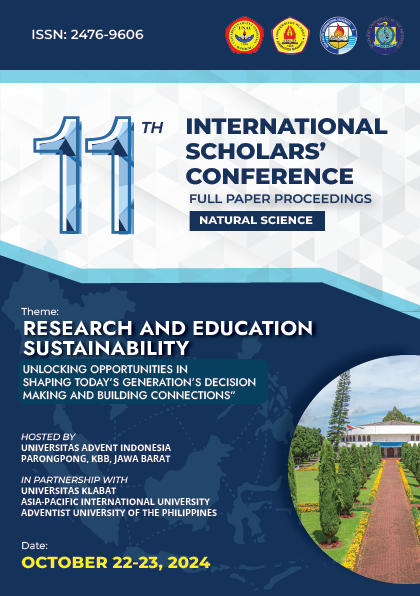In-Silico ADMETox Profiling of Quercetin Derivatives
Keywords:
quercetin, ADMETox, similarity, computational dockingAbstract
Quercetin, a flavonoid with known pharmacological properties, has garnered significant attention for its potential therapeutic applications. To explore its derivatives for drug development, this study conducted an in-silico ADMETox (Absorption, Distribution, Metabolism, Excretion, and Toxicity) profiling. A diverse set of Quercetin derivatives was obtained from computational analysis using SwissSimilarity tools. We have fishing as much as 400 structures, which are restricted to 20 structure which having similarity higher than 90%. Key ADMETox properties, including solubility, permeability, CYP450 inhibition, and toxicity, were predicted. The results revealed that structural modifications in Quercetin derivatives significantly influenced their ADMETox profiles. Specific structural features were identified that correlated with improved or worsened properties. These findings provide valuable insights for the rational design of Quercetin derivatives with optimized pharmacokinetic and safety profiles, paving the way for their potential development as therapeutic agents.
Downloads
References
Anand David, A. V., Arulmoli, R., & Parasuraman, S. (2016). Overviews of Biological Importance of Quercetin: A Bioactive Flavonoid. Pharmacognosy Reviews, 10(20), 84–89. https://doi.org/10.4103/0973-7847.194044
Austin, A., Colyson, J. H., Rohmatulloh, F. G., Destriani, W., & Rosyati, M. M. (2023). Potential of Indonesian Medicinal Plant Biodiversity as CHK1 Inhibitor Agent for Cancer Treatment by Bioinformatics and Computational Chemistry. Indonesian Journal of Computational Biology (IJCB), 2(1), 1–10. https://doi.org/10.24198/ijcb.v2i1.45150
Bragina, M. E., Daina, A., Perez, M. A. S., Michielin, O., & Zoete, V. (2022). The SwissSimilarity 2021 Web Tool: Novel Chemical Libraries and Additional Methods for an Enhanced Ligand-Based Virtual Screening Experience. International Journal of Molecular Sciences, 23(2), Article 2. https://doi.org/10.3390/ijms23020811
Carrillo-Martinez, E. J., Flores-Hernández, F. Y., Salazar-Montes, A. M., Nario-Chaidez, H. F., & Hernández-Ortega, L. D. (2024). Quercetin, a Flavonoid with Great Pharmacological Capacity. Molecules, 29(5), Article 5. https://doi.org/10.3390/molecules29051000
Daina, A., Michielin, O., & Zoete, V. (2017). SwissADME: A free web tool to evaluate pharmacokinetics, drug-likeness and medicinal chemistry friendliness of small molecules. Scientific Reports, 7(1), 42717. https://doi.org/10.1038/srep42717
Johnston, C. U., & Kennedy, C. J. (2024). A Review of P-Glycoprotein Function and Regulation in Fish. Fishes, 9(2), Article 2. https://doi.org/10.3390/fishes9020051
Lam, T.-P., Tran, N.-V. N., Pham, L.-H. D., Lai, N. V.-T., Dang, B.-T. N., Truong, N.-L. N., Nguyen-Vo, S.-K., Hoang, T.-L., Mai, T. T., & Tran, T.-D. (2024). Flavonoids as dual-target inhibitors against α-glucosidase and α-amylase: A systematic review of in vitro studies. Natural Products and Bioprospecting, 14(1), 4. https://doi.org/10.1007/s13659-023-00424-w
Massi, A., Bortolini, O., Ragno, D., Bernardi, T., Sacchetti, G., Tacchini, M., & De Risi, C. (2017). Research Progress in the Modification of Quercetin Leading to Anticancer Agents. Molecules : A Journal of Synthetic Chemistry and Natural Product Chemistry, 22(8), 1270. https://doi.org/10.3390/molecules22081270
Michala, A.-S., & Pritsa, A. (2022). Quercetin: A Molecule of Great Biochemical and Clinical Value and Its Beneficial Effect on Diabetes and Cancer. Diseases, 10(3), 37. https://doi.org/10.3390/diseases10030037
Muñoz-Reyes, D., Morales, A. I., & Prieto, M. (2021). Transit and Metabolic Pathways of Quercetin in Tubular Cells: Involvement of Its Antioxidant Properties in the Kidney. Antioxidants, 10(6), 909. https://doi.org/10.3390/antiox10060909
Qi, W., Qi, W., Xiong, D., & Long, M. (2022). Quercetin: Its Antioxidant Mechanism, Antibacterial Properties and Potential Application in Prevention and Control of Toxipathy. Molecules, 27(19), 6545. https://doi.org/10.3390/molecules27196545
Stefaniu, A., & Pirvu, L. C. (2022). In Silico Study Approach on a Series of 50 Polyphenolic Compounds in Plants; A Comparison on the Bioavailability and Bioactivity Data. Molecules, 27(4), Article 4. https://doi.org/10.3390/molecules27041413
Tsantili-Kakoulidou, A., & Demopoulos, V. J. (2021). Drug-like Properties and Fraction Lipophilicity Index as a combined metric. ADMET & DMPK, 9(3), 177–190. https://doi.org/10.5599/admet.1022
Yi, H., Peng, H., Wu, X., Xu, X., Kuang, T., Zhang, J., Du, L., & Fan, G. (2021). The Therapeutic Effects and Mechanisms of Quercetin on Metabolic Diseases: Pharmacological Data and Clinical Evidence. Oxidative Medicine and Cellular Longevity, 2021, 6678662. https://doi.org/10.1155/2021/6678662
Zhao, M., Ma, J., Li, M., Zhang, Y., Jiang, B., Zhao, X., Huai, C., Shen, L., Zhang, N., He, L., & Qin, S. (2021). Cytochrome P450 Enzymes and Drug Metabolism in Humans. International Journal of Molecular Sciences, 22(23), 12808. https://doi.org/10.3390/ijms222312808
Downloads
Published
How to Cite
Issue
Section
License
Copyright (c) 2024 11th International Scholars Conference

This work is licensed under a Creative Commons Attribution-ShareAlike 4.0 International License.
Copyright © 2024 ISC Committee.















